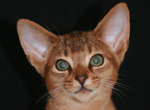

Health
Click on a topic to find out more about it:
Progressive retinal atrophy is known as PRA. It is a genetically linked disease found in Abyssinian cats and Abyssinian crossbreeds such as the ocicat. A cat may be normal, a carrier or affected. An affected cat may lose its sight as it gets older. A DNA test has been dvised to determine whether a cat carries the gene. All our breeding cats have been tested for PRA or are PRA normal. Click on the link below to find out more.
Tritrichomonas foetus is a parasite that has only recently been discovered in the Australian cat population. It is found in the cat's colon and is excreted in their stools. It causes chronic, smelly diarrhoea that often contains blood and mucus. Research is still being done on this protozoan to determine the long-term effects it may have on a cat. There are several ways to test for it; however, the most reliable is by polymerase chain reaction (PCR) that is only available through certain laboratories. It is currently treated with a drug called Ronidazole which has to be prepared by a specialist compounding pharmacy.
Pyruvate kinase is an enzyme that is required to maintain a cell’s metabolism. In cats, if there is a deficiency of the enzyme they may have bouts of anaemia. Anaemia is a blood condition in which there are not enough red blood cells or the red blood cells are deficient in haemoglobin, resulting in poor health. These cats are still expected to have a normal life span unlike their canine companions. Abyssinian, Somali and domestic short-hair cats are known to carry and be affected by the deficiency. It is a genetic condition and the disease is acquired when a cat receives a recessive gene from each parent (homozygous affected). A cat may carry the disease by receiving one recessive gene (heterozygous form) from a parent. These affected cats although healthy need to be detected in a breeding cat population as genetic mutations are possible. A DNA test is possible that identifies both carriers and affected cats. All our cats are Pkdef free.
Feline leukemia virus
Feline leukemia virus is found in some wild cat and domestic cat populations. There are three forms of the virus FeLV-A, FeLV-B and FeLV-C. FeLV-A is found in all feline leukemia virus infected cats and results in a weakened immune system known as immunosuppression. An FeLV-A infected cat may also be infected with FeLV-B and/or FeLV-C. FeLV-B results in an increased number of abnormal tissue growths such as tumors and is known as neoplastic disease. If your cat is very unlucky and has acquired FeLV-C it will have severe anaemia.
The symptoms of the virus take two to four weeks to show up after the infection of the blood. The rest of the body is infected as the virus reproduces in the tonsils and pharyngeal lymph nodes and continues to spread via the bloodstream. The lymph nodes, bone marrow and intestinal tissue seem to be particularly prone to the virus. Keeping your cat inside and in good health will help reduce the chance of it being infected with FeLV. FeLV tends to be a saliva spread virus so transmission from one cat to another is possible via bite wounds, mouth and nose contact, shared litter and food trays and grooming. A pregnant mother that is infected with FeLV may pass the virus on to her offspring and blood transfusions are another possible transmission path. Urinary and faecal transmission of the virus is also possible. Transmission of FeLV to humans is not possible.
Feline immunodeficiency virus
Feline immunodeficiency virus (FIV) is a virus that attacks the cat’s immune system, weakening it and making it prone to other infections and diseases. It is fatal and there is no cure for FIV. Feline immunodeficiency virus infection is similar to the HIV infection found in humans. A cat with FIV may live for a long time with out showing signs of illness as the virus slowly infects the immune system. Bite wounds usually pass the virus from one cat to another.
Ringworm
Ringworm is a fungal infection, not a worm, which humans and cats may get. It can be transferred from human to cat and vice versa as well as between the same species.
On cats ringworm usually shows up as a scaly patch of skin that has lost fur. It may occur as a circular type lesion whose circumference continues to increase as the fungus spreads. If you suspect your cat has ringworm take it to the vet for an examination under a Wood’s lamp where affected hairs may show up lime green, and a toothbrush fungal culture which involves brushing the fur and infected area with a sterile toothbrush. The bristles are then placed onto the surface of a culture plate and incubated for 2-4 weeks.
If the results indicate that ringworm is present it is important that all surfaces that the cat has been in contact with are cleaned. Bedding and clothes should be washed with an antifungal product and the cat can be washed in a pet friendly product such as Malaseb. Cats can also be given a course of tablets by the vet. The fungal spores are airborne and can lay dormant for a long time so you need to be very vigilant with your cleaning regime to eradicate the fungus totally from your home and cats.
Make sure you treat your cats regularly for fleas and worms. Clean their bedding and litter tray areas frequently to minimise the occurence of these parasites. There are many preventative products for the treatment of fleas and worms on the market.
Keep your cats inside to reduce their chance of being involved in cat fights, picking up parasites and viruses.